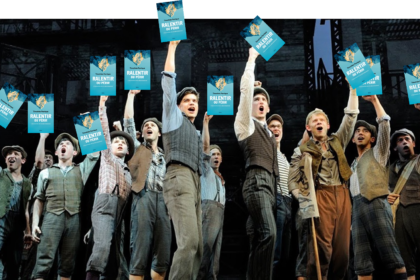My usual soapbox
This February, I attended the Air-Conditioning, Heating, & Refrigerating Expo (aka AHR Expo), the world’s largest tradeshow for HVACR & building automation professionals. I spent my days attending educational sessions, walking the show floor to see the latest offerings, meeting with customers, and networking with industry peers.
On my last day at the conference, over a martini, my new acquaintance James Dice (have you heard of him?) asked me, “What are your main takeaways from the week?” I felt a twinge of guilt. I wished I had some emerging market trend or cutting-edge technology to discuss, but my heart was captured, as ever, by Diversity, Equity, & Inclusion (DEI).
Sometimes I feel bad about being the Diversity Girl. I bring DEI into everything. I’m the person who will (tactfully) call out sexism, racism, ableism, homophobia, etc. etc. etc. whenever I see it, and since I’m in a technical field, this is a near daily occurrence for me. I imagine people who aren’t marginalized are annoyed by it, but I perpetually stand on this soapbox because inequality and injustice are the crux of so many problems, including the climate crisis.
So, why am I harping on DEI once again? Because at the AHR Expo, the issue of the labor shortage in the US came up in every conversation, yet not once was the issue of diversity, equity, & inclusion mentioned. Many experts waxed poetic about how to solve the labor shortage and get Gen Z interested in joining the building industry without ever asking the question: Who are these Gen Zers, and what do they want?
Math
Anto Budiardjo, CEO of Padi.io and founding member of the Coalition for Smarter Buildings, summed up the magnitude of the labor shortage with this approximation:
“There are roughly 5.5 million commercial buildings in the US. Less than 10% have any ‘smarts’ in them, so let’s say 5 million do not. Let’s take 20% of that as worthy of smarts. On the aggressive schedule of the Biden agenda, let’s say we try to make 1 million buildings smart over 5 years, which is 200,000 a year, or around 800 per day… The cost (and time) of integration alone would make that rate impossible.”
One approach to solving the labor shortage problem is on the product side — if we develop building management systems that are simpler to install, configure, integrate, and operate, then we will reduce the time required for each job and complete more projects across the industry per day. While this is completely true and necessary, we won’t fix our deployment problems with simpler tech alone. At the end of the day, humans are still needed to do this work, and with 10,000 people reaching retirement age per day in the United States, we must look to the next generation to replace that talent and expertise.
Which brings us to our next question: Who is the next generation? Let’s do some more math.
Gen Z is increasingly multiethnic and increasingly LGBTQ-identifying. Only 52% of Gen Z is non-hispanic white (compared to 82% for Baby Boomers, 70% for Gen X, and 61% for millenials), and 21% of Gen Z identifies as LGBTQ+. In general, most Gen Zers are progressive and see growing racial and ethnic diversity as a good thing.
So what are the implications of these demographics?
- If you aren’t marketing your organization to women, that cuts your talent pool down roughly to 50%.
- Within your remaining 50%, if you aren’t marketing your organization to people of color, that’s an additional 48% gone.
- Further, if you aren’t marketing your organization to LGBTQ+ people, take out another 21%.
Which leaves you with: 50% male x 52% white x 79% cisgender heterosexual = only 20% of the total population.

Now stay with me — I know this is a very rough approximation, and of course, there are exceptions. I am one of these exceptions being LGBTQ+, female, and Asian-Hispanic American. But understand that this is very much like product marketing: the majority of the people who will buy your product are the ones that you target with your messaging. By not prioritizing DEI, you may have unwittingly reduced the talent pool from which you can pull to a measly 20%. We won’t deploy smart building tech — even easy-to-deploy tech — if only 20% of the people that could do these jobs actually have the desire to do them.
Marketing DEI
Why am I insisting on the idea of marketing the industry as diverse, equitable, and inclusive? Because the reputation of engineering & the trades is bad. Real bad.
My first internship as a freshman in college was at a small family-run engineering firm where I worked in the electrical & instrumentation department creating CAD drawings. I was 19 years old and so excited to be a real engineer. During my 2.5 months there, I was sexually harassed several times and told by both HR and the CEO that the perpetrator was a “good guy” and “didn’t mean it.” From that experience, I decided I would only ever work at large corporations where the HR department, policies, and protections were more robust.
Anecdotally, every single woman I know who works on the front-end (meaning she goes to construction sites), has at least one horror story of being harassed or even assaulted by men in the field. I also have a trans friend who was an extraordinarily sharp programmer and cybersecurity expert at a controls contractor. I say “was” because they have since left the industry due to fear of being outed and harmed by coworkers.
Can you blame marginalized people for not wanting to work in the trades? Word gets out, and this doesn’t just happen to me and my friends. A 2022 study showed that trades work is hostile and unsupportive of women due to sexual harassment, lack of properly fitting personal protective equipment, social isolation, and a need to prove oneself, just to name a few impacts.
So, back to marketing. I think there is a chicken & egg situation with DEI marketing. If you say your company cares about DEI without actually improving company culture and policies, then people will walk out the door as fast as they walked in. They will realize that there is no substance to your claims. You get labeled as purple-washing, pink-washing, rainbow-washing, etc.
That being said, you also don’t really start to make real progress until you visibly demonstrate that DEI matters to your company. Communicating the company’s stance on DEI is important because when you show your heart and your values, then more people become empowered. Employees start speaking up for what they need and want in a workplace because they believe leadership supports them, and the culture and policies actually start to move.
Let’s take a hypothetical: Unless your company publicly announces that you are an LGBTQ+ friendly workplace AND you are transparent about the policies in place to support LGBTQ+ employees, how would an LGBTQ+ job candidate know that you can provide a safe and supportive work environment? For LGBTQ+ people in this country, this decision is a matter of physical health & safety. If they aren’t confident you can meet this need, they may look elsewhere for employment. In fact, many LGBTQ+ people use the Human Rights Campaign Corporate Equality Index — a tool for benchmarking how corporations across the United States and beyond are adopting equitable workplace policies, practices, and benefits for LGBTQ+ employees — when choosing where they want to work.
What to do, what to do…
The longer I think about it, the more I shake my head and laugh at how ludicrous it is to have a conversation about workforce without centering diversity. It’s nibbling around the edges of the problem. All the high school intervention and apprentice programs in the world won’t help if 80% of students don’t see themselves thriving in this industry.
So how is the building industry — which is 97% male (mostly white, straight, cisgender men, at that) — going to appeal to this diverse generation?
I started writing a list of all the things I could think of that building professionals can take action on to improve Diversity, Equity, & Inclusion, but then I remembered: it’s not my responsibility. I’m doing the best I can by leading DEI efforts at my company, participating in many different DEI-focused professional organizations, writing and speaking about DEI in my free time, and generally just existing as a queer, multiethnic woman. It’s time for the 97% to share the load.
In this essay, I have demonstrated how attracting & retaining diverse talent is central to solving the labor shortage and to ensuring the longevity and success of the building industry. I’ve pointed you toward the opportunity. To borrow the words from Melissa Boutwell (President of Automation Strategy & Performance), it is now your job to “magnetize people to this industry.”




